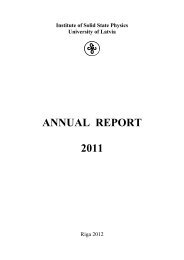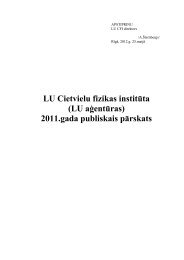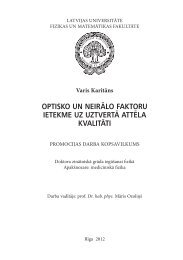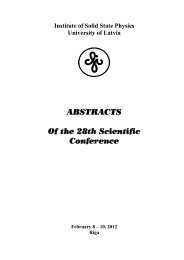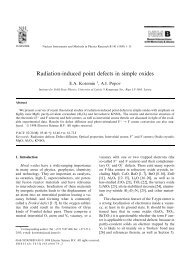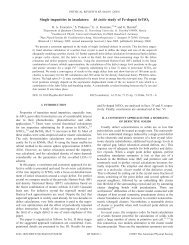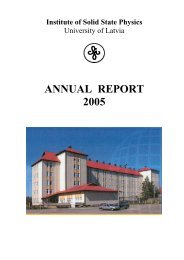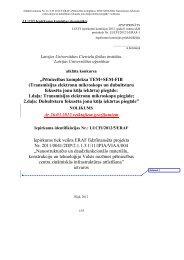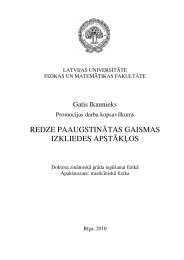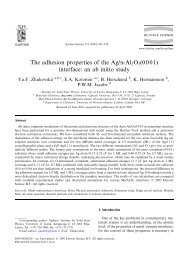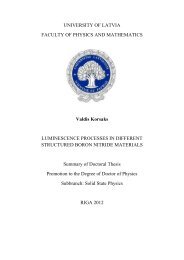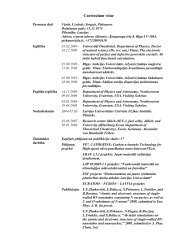Annual Report 2012 - Latvijas Universitātes Cietvielu fizikas institūts
Annual Report 2012 - Latvijas Universitātes Cietvielu fizikas institūts
Annual Report 2012 - Latvijas Universitātes Cietvielu fizikas institūts
Create successful ePaper yourself
Turn your PDF publications into a flip-book with our unique Google optimized e-Paper software.
in terms of colour coordinate dispersion for printing methods used is much higher than<br />
in case of commercially available colour vision deficiency tests.<br />
RAYLEIGH EQUATION ANOMALOSCOPE FROM COMMERCIALLY<br />
AVAILABLE LEDs<br />
R. Trukša, S. Fomins, and M. Ozolinsh<br />
Most precise classification of CVD (color vision deficits) can be provided by using<br />
anomaloscope. Today anomaloscopes are available, which can evaluate red-green<br />
(Rayleigh) and blue-green (Moreland) color defects. Our aim is to create and calibrate<br />
commercially available LEDs based anomaloscope for diagnosis of red-green color<br />
vision defects. Other field of use of anomaloscope is a seasonal and overall variation of<br />
normal color vision in Latvian population.<br />
LED BASED DUAL WAVELENGTH HETEROCHROMATIC FLICKER<br />
METHOD FOR SEPARATE EVALUATION OF LUTEIN AND<br />
ZEAXANTHIN IN RETINA<br />
M. Ozolinsh and P. Paulins<br />
The decrease of density and consequentially optical density of macular pigment serves<br />
as a diagnostic mean for a number of ophthalmological pathologies, particularly as a risk<br />
factor for age related macular degeneration. Macular pigment absorbs light in short<br />
wavelength blue spectral range. Thus the optical density of macular pigment can be<br />
detected by various optical – both objective and subjective psychophysical techniques.<br />
Latter techniques use eye and brain visual pathway as spectral sensitive optical detector<br />
and decision maker, and exploit perception facility to process information flow in a<br />
unique manner to create various perception illusions. The psychophysical methods of<br />
detection of optical density of macular pigment include heterochromatic flicker<br />
photometry and minimum illusory motion photometry. We develop and employ a<br />
heterochromatic flicker photometry method where LEDs are used as visual stimuli. LED<br />
emission maximum wavelengths in blue spectrum region are chosen in range 445-460<br />
nm, that corresponds to spectrally resolved maxima of light absorption for two types of<br />
macula pigments – lutein and zeaxanthin or in spectral range 500-510 nm, where lutein<br />
and zeaxanthin absorption have decay, that for both type of pigments have a detectable<br />
shift. Statistical dispersion of the results allows to use the difference between results of<br />
psychophysical measurements obtained for different LEDs to estimate the concentration<br />
of lutein and zeaxanthin in human retina.<br />
APPLICABILITY OF A BINARY AMPLITUDE MASK FOR CREATING<br />
CORRECTORS OF HIGHER-ORDER OCULAR ABERRATIONS IN A<br />
PHOTORESISTIVE LAYER<br />
V. Karitans, K. Kundzins, E. Laizane, M. Ozolinsh, and L. Ekimane<br />
Ocular aberrations can be corrected with wavefront correctors created in a photoresist<br />
layer. The simplest type of the mask used in optical lithography is a binary amplitude<br />
mask. It is known that such a mask has a periodic hole pattern. The purpose of this<br />
research was to assess applicability of a binary amplitude mask for creating ocular<br />
wavefront correctors. The photoresist was applied to the substrate by using the dipcoating<br />
method. The photoresist layer was illuminated through a mask printed on a<br />
49



